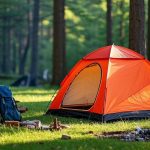Discover the essential kayaking gear for beginners with this complete checklist. Learn what to bring, what to skip, and how to stay safe and comfortable on your first paddling trip.
Getting into kayaking is exciting — but all the gear can feel overwhelming at first. Do you really need dry bags? What’s a bilge pump? And how much should you spend?
As a beginner, it’s easy to either overspend on the wrong gear or skip essentials that keep you safe and comfortable.
In this guide, you will find the break down of the must-have kayaking equipment, the safety gear you can’t skip, and the nice-to-have items that improve every trip — without pushing unnecessary gear. You can also have the free printable kayaking gear for beginners checklist below.

Table of Contents
Kayaking Gear For Beginners
These are the core items every beginner kayaker needs to stay safe and have fun:
1. Personal Flotation Device (PFD)
A proper paddling PFD (not a generic life vest) is the most important item on your list. Even calm waters can be unpredictable, and you’re legally required to have one in most places.
💡 Look for a Type III paddling-specific life jacket — with large armholes and a snug, low-profile fit for easy movement.
Price Range: $60–$120
Pro Tip: Attach a whistle to your PFD for safety signaling.
2. Quality Paddle (Plus a Spare)
Your paddle is your engine — don’t skimp here. Cheap, heavy paddles lead to shoulder fatigue and poor performance.
💡 For beginners, start with an aluminum or fiberglass paddle (around 220–240 cm long) with plastic blades.
Price Range: $40–$100
Don’t Forget: Always carry a backup paddle if going more than a few minutes from shore.
3. Weather-Appropriate Clothing
Avoid cotton at all costs — it holds water and chills you fast. Choose synthetic, quick-dry clothing that matches the water temperature, not just the air.
💡 Warm weather? Rash guard + board shorts.
Cool temps? Thermal base layer + waterproof shell.
Extras to consider:
- Wide-brimmed hat or cap
- Water shoes or neoprene booties
- Sunglasses with a strap
Safety Gear You Shouldn’t Skip
Kayaking is fun — but safety comes first. These items may seem small, but they make a huge difference in emergencies.
4. Whistle
Small but vital. A whistle is the universal distress signal on water — three short blasts can get you noticed fast.
💡 Most paddling PFDs include a whistle clip, but if not, buy a waterproof whistle and clip it securely to your life jacket.
5. Bilge Pump or Bailer
Even if you’re in a sit-on-top kayak, water will get in eventually. A bilge pump or scoop helps you empty water quickly.
💡 Sit-inside kayaks absolutely require one — a flooded cockpit is no joke if you’re far from shore.
6. Waterproof First Aid Kit
Injuries happen — whether it’s a blister, cut, or headache. A compact, waterproof first aid kit gives you peace of mind.
Pack basic items like:
- Bandages
- Pain relievers
- Antiseptic wipes
- Tweezers
- Emergency blanket
Must-Have Accessories That Make Life Easier
These aren’t mandatory, but once you use them, you won’t want to go without.
7. Dry Bags
Protect your phone, food, and extra clothes from getting soaked. Dry bags come in all sizes and are essential for longer trips.
💡 Use small dry bags for keys/wallet, medium for snacks, and large for spare clothes or camping gear.
Tip: Roll down the top at least three times and push out air before sealing.
8. Sun Protection
Sunburn can ruin your day fast — and UV rays bounce off water.
Essentials include:
- Waterproof sunscreen (SPF 30+)
- Polarized sunglasses (with floating strap)
- UPF-rated shirts or rash guards
- Wide-brimmed hat or cap
9. Comfort Items
- Seat cushion for longer paddles
- Paddle gloves to prevent blisters
- Neoprene booties for grip and warmth
Navigation & Communication Tools
Don’t rely only on your phone. Prepare for off-grid situations or unexpected changes.
10. Waterproof Map & Compass
Tech can fail. A laminated or dry-bagged map plus a basic compass keeps you on course when visibility drops.
11. Backup Communication Device
- Short trips: Phone in waterproof case
- Remote locations: VHF marine radio or satellite beacon
💡 The U.S. Coast Guard monitors VHF Channel 16 for emergencies.
Seasonal Gear for Year-Round Kayaking
Cold Weather Essentials
Cold water can be more dangerous than cold air. If you’re paddling in temperatures below 60°F, invest in:
- Neoprene gloves and booties for warmth and grip
- Thermal base layers and a dry suit or wetsuit
- Skull cap or beanie that retains heat even when wet
- Hand warmers tucked into your dry bag
Hot Weather Must-Haves
Warm-weather kayaking can lead to dehydration or heat exhaustion. Be prepared with:
- Hydration pack or large water bottle
- UV-protective clothing (long sleeve rash guards work great)
- Cooling towel or hat with ventilation
- Electrolyte tablets or snacks to replenish lost nutrients
Beginner Mistakes to Avoid
Even with the right kayaking gear for beginners, avoid these common errors:
🚫 Wearing cotton – It gets cold when wet and dries slowly.
🚫 Not checking weather/water conditions – Wind and current matter as much as rain.
🚫 No float plan – Always tell someone your route and return time.
🚫 Overpacking – Start with essentials; too much gear makes your kayak harder to manage.
🚫 Ignoring fit and comfort – PFDs, paddles, and seat pads should fit you well or you’ll hate your time on the water.
Learning from these mistakes helps you stay safe, comfortable, and ready for your next paddle.
Free Printable Kayaking Checklist
Want to make sure you have everything before you hit the water?
We’ve put together a simple, printable kayaking checklist that covers all the must-have safety gear, clothing essentials, and optional extras from this guide.
✅ Perfect for first-time paddlers
✅ Helps you pack smarter and safer
✅ Great for day trips or weekend paddling adventures
👉 Download your free checklist here
Getting Started with the Right Setup
Before investing in all this kayaking gear for beginners, make sure you’ve chosen the right kayak for your needs. Our guide on How to Choose a Kayak for Beginners: 7 Factors You Shouldn’t Skip covers everything from hull design to storage capacity.
If you’re still deciding between kayak styles, check out our detailed comparison of Sit-On-Top vs Sit-Inside Kayaks: Which is Better for Beginners? The type of kayak you choose affects what gear you’ll need most.
Frequently Asked Questions
-
Do I need to buy all this gear before my first trip?
Not at all! Many beginners start by renting or borrowing gear. Focus first on safety essentials: PFD, paddle, and proper clothing.
-
What’s the difference between a sit-on-top and sit-inside kayak for gear?
Sit-inside kayaks require more safety gear like bilge pumps. Sit-on-tops are easier for beginners and often need less specialized equipment.
-
Is it okay to wear regular clothes?
Avoid cotton—opt for synthetic or quick-dry materials. Wet cotton can make you cold and uncomfortable fast.
-
How do I choose the right paddle size?
Most beginners do well with a 220–240cm paddle. Your height and kayak width will affect the ideal length.
-
Do I need a wetsuit?
Only if the water temperature is below 60°F. In most cases, layered synthetic clothing will work.
-
Can I bring my phone kayaking?
Yes, but use a waterproof case with a float strap—and keep it in a dry bag when not in use.







